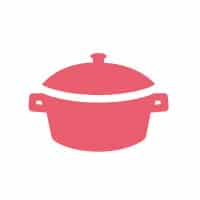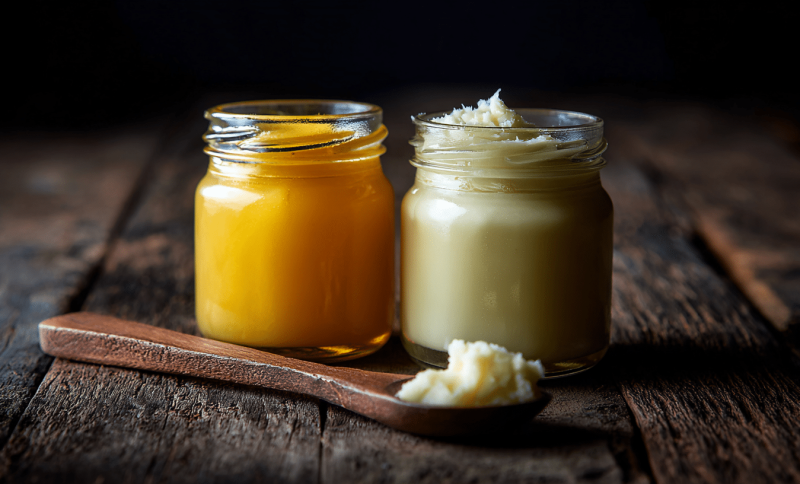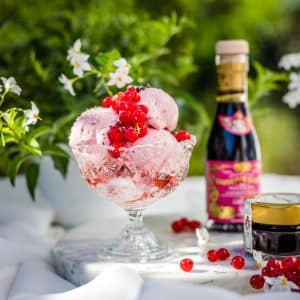For decades, doctors told us to avoid saturated fats. Now nutrition experts are saying some traditional animal fats might actually be healthier than processed vegetable oils.
This complete reversal has left many home cooks confused about which fats are safe to use.
Two fats gaining attention are ghee and tallow – both high in saturated fats we were taught to fear. Ghee comes from clarified butter, while tallow is rendered beef fat.
Both have been used for centuries but fell out of favor during the low-fat diet craze. Understanding their real differences helps you make informed choices for your kitchen and health goals.
What Is Ghee?
Ghee is basically butter with all the water and milk bits removed. Think of it as butter’s concentrated cousin. It started in India thousands of years ago and has been a cooking staple there ever since.
Making ghee is like a slow, careful process. You heat butter gently until the water evaporates and the milk solids turn golden brown. What’s left behind is pure, golden fat that smells nutty and delicious.
The cool thing about ghee is that it’s almost like magic butter. Since the milk parts are gone, even some people who can’t handle dairy can often eat ghee without problems. It also lasts much longer than regular butter without going bad.
How Ghee Is Made
Making ghee is surprisingly simple. You start with good-quality butter and heat it slowly in a pan. As it melts, the water bubbles away and the milk solids sink to the bottom, turning golden brown.
You keep cooking until the bubbling stops and it smells nutty. Then you strain out the brown bits, leaving behind pure, golden ghee.
What Is Tallow?
Tallow comes from beef fat, especially the hard fat around the kidneys called suet. Before vegetable oils became popular, tallow was the go-to cooking fat in many homes.
Your great-grandmother probably used it all the time.
To make tallow, you slowly heat beef fat until it melts and turns into a smooth, creamy fat. It’s like how you might render bacon fat, but with beef instead of pork.
Tallow has been used for cooking for hundreds of years. It was so valuable that people used it not just for cooking, but also for making candles and soap. That shows how useful and long-lasting this fat really is.
How Tallow Is Made
Making tallow takes patience but isn’t complicated. You start with beef fat, especially the hard fat around the kidneys. Cut it into small pieces and heat it slowly in a heavy pot.
As it melts, the fat separates from any meat bits. You strain the liquid fat through cheesecloth to remove any solids. What’s left is pure, creamy white tallow that hardens as it cools.
Nutrition Breakdown: The Numbers Game
Let’s look at what’s inside these fats. Both ghee and tallow are almost pure fat, but they have different types.
| Nutrition Facts (per tablespoon) | Ghee | Tallow |
|---|---|---|
| Calories | 120 | 115 |
| Total Fat | 14g | 13g |
| Saturated Fat | 9g | 6g |
| Monounsaturated Fat | 4g | 6g |
| Polyunsaturated Fat | 0.5g | 1g |
| Cholesterol | 33mg | 14mg |
| Vitamin A | High | Moderate |
| Vitamin D | Present | Present |
| Vitamin K | Present | Present |
| Special Compounds | Butyrate | CLA |
| Lactose/Casein | Very low | Zero |
| Dairy Content | Yes (processed) | No |
Both fats are high in saturated fat, which has a bad reputation. But newer research suggests that natural saturated fats might not be as harmful as once thought, especially when part of a balanced diet.
Health Benefits: The Good Stuff
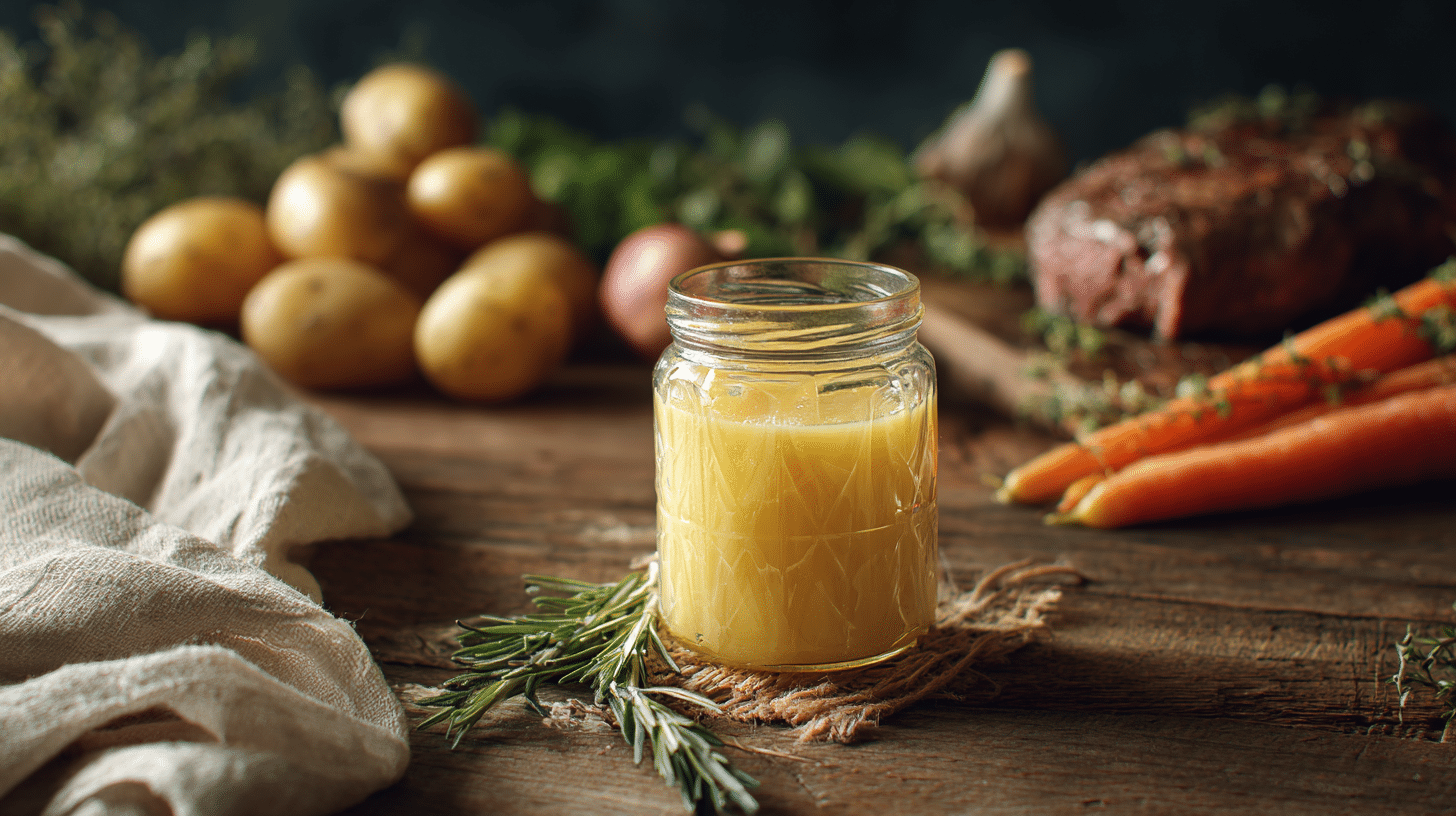
Both ghee and tallow offer unique health benefits that make them stand out from regular cooking oils. Here’s what makes each one special for your health.
1. Ghee’s Health Perks
Ghee provides impressive benefits for your gut, cooking stability, and overall nutrition.
- Gut Health Support: Contains butyrate, which feeds the good bacteria in your intestines and supports digestive health
- High Heat Stability: With a smoke point of 485°F, it doesn’t break down or create harmful compounds during high-temperature cooking
- Easy Vitamin Absorption: Fat-soluble vitamins A, D, and K are readily absorbed by your body for immune and bone health
- Lactose-Free Benefits: Most people with dairy sensitivities can tolerate ghee since milk proteins are removed
2. Tallow’s Health Benefits
This beef fat excels in cooking performance and provides unique nutritional compounds.
- Superior Heat Stability: One of the most stable fats for cooking, won’t go rancid easily and saves you money
- Muscle Building Support: Contains CLA (conjugated linoleic acid) which may help with weight management and muscle development
- Grass-Fed Advantages: Tallow from grass-fed cattle provides even higher levels of beneficial nutrients and omega-3s
- Zero Carb Content: Perfect for low-carb, keto, and carnivore diets with no carbohydrates whatsoever
3. The Potential Downsides
While both fats have benefits, there are some important considerations to keep in mind.
Both fats are rich in saturated fat, so use them in moderation and consult your doctor if you have heart issues
Tallow’s beefy taste can overpower delicate dishes and isn’t suitable for all recipes
Both can be more expensive than vegetable oils, though many consider the health benefits worth the investment
Which Is Better for Cooking?
The answer depends on what you’re cooking and your taste preferences. Ghee works better for everyday cooking because of its nutty flavor that complements both sweet and savory dishes.
It’s perfect for sautéing vegetables, baking, and Indian cuisine. Tallow shines when you need maximum heat stability for deep frying or want that rich, beefy flavor in roasted meats and vegetables.
For most home cooks, ghee is the smarter starting choice since it’s more widely available and works in more recipes, while tallow is ideal for specific high-heat cooking tasks.
Using Ghee and Tallow in Your Kitchen
Understanding how to use these fats properly will help you get the best results in your cooking and storage.
1. Cooking Applications: Where They Shine

Here’s how each fat performs in different cooking methods and what makes them special in the kitchen.
| Cooking Method | Ghee | Tallow |
|---|---|---|
| Best For | Everyday cooking, baking, and Indian cuisine | High-heat cooking, deep frying, and savory dishes |
| Smoke Point | 485°F | 400-420°F |
| Flavor Impact | Nutty, buttery richness | Bold, beefy, savory |
| Sautéing | Excellent – makes vegetables taste amazing | Good – adds meaty flavor |
| Baking | Perfect butter substitute | Great for pie crusts and savory baking |
| Deep Frying | Good stability | Excellent – crispiest results |
| Roasting | Ideal for potatoes and vegetables | Perfect for high-heat roasting |
| Versatility | Swiss Army knife of fats | Heavyweight champion for intense heat |
2. Taste and Aroma: The Flavor Factor
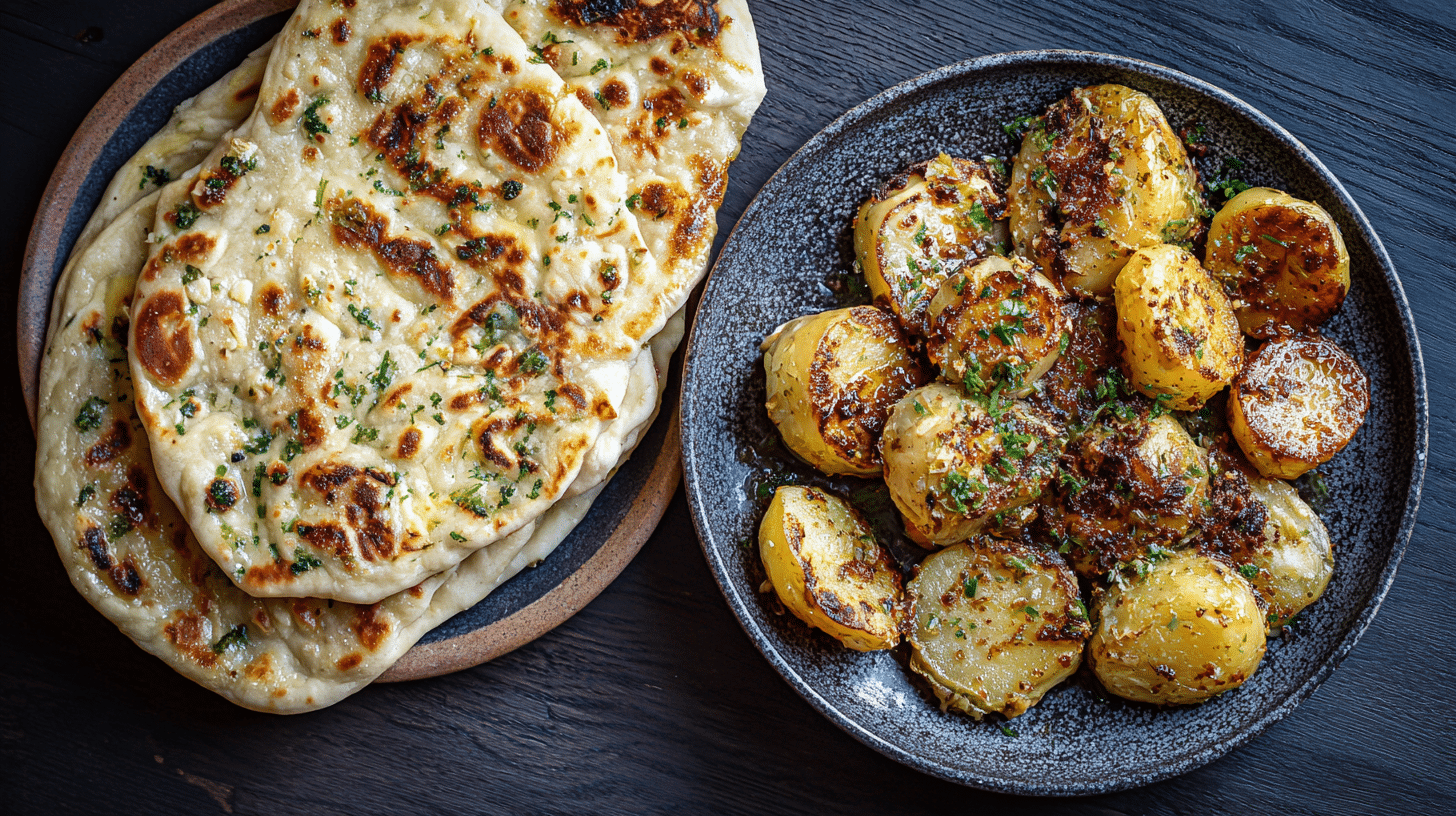
Ghee tastes like butter’s more sophisticated cousin. It has a rich, nutty flavor with hints of caramel. The slow cooking process creates these complex flavors that regular butter just can’t match.
The aroma is warm and inviting – like walking into a bakery. It adds depth to both sweet and savory dishes without being overwhelming.
Tallow has a distinctly beefy, savory flavor. It’s rich and meaty, which can be amazing in the right dishes but might not work everywhere.
Some people describe it as having an almost bacon-like richness. If you love the taste of beef, you’ll probably enjoy cooking with tallow.
3. Storage and Shelf Life: Making Them Last
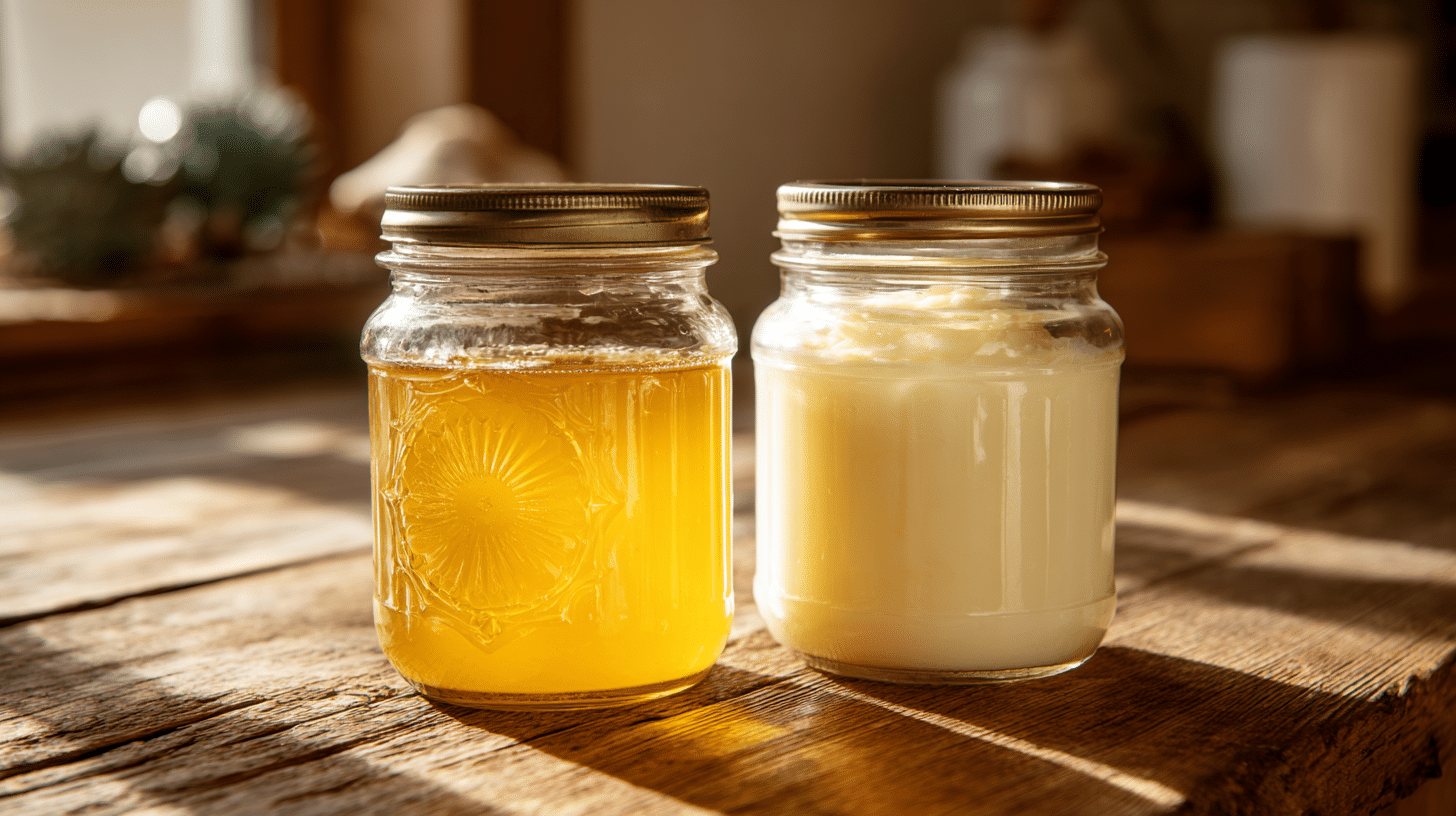
Both ghee and tallow are shelf-stable, which means they don’t need refrigeration if stored properly.
Storing Ghee
- Room Temperature: Keep in an airtight container, lasts for months
- Refrigerated: Can last up to a year when properly stored
- Signs of Spoilage: Off smell, unusual color, or strange texture
- Clean Handling: Always use clean utensils to prevent contamination
Storing Tallow
- Room Temperature: Store in a cool, dark place in an airtight container for months
- Refrigerated: Lasts up to a year, even more stable than ghee
- Freezer Storage: Both fats can be frozen for an extended shelf life
- Best Practices: Use clean utensils and keep containers sealed tightly
The Final Verdict
Both ghee and tallow are excellent cooking fats with their own strengths. Ghee wins for versatility and flavor that works in many dishes. Tallow takes the crown for high-heat cooking and maximum stability.
If you’re just starting out, try ghee first. It’s easier to find, works in more recipes, and has a flavor most people enjoy.
Once you’re comfortable with ghee, experiment with tallow for specific dishes like roasted vegetables or fried foods.
Remember, these are traditional fats that humans have used for thousands of years. They can be part of a healthy diet when used in moderation.
Choose high-quality, grass-fed options when possible, and don’t be afraid to experiment. The best cooking fat is the one that makes your food taste amazing and fits your lifestyle.
Frequently Asked Questions
Is Ghee Or Tallow Better For Reducing Cholesterol?
Neither fat is specifically better for cholesterol. Both are high in saturated fat, so moderation is important regardless of which you choose.
Can People With Dairy Allergies Eat Ghee?
Many people with dairy allergies can tolerate ghee because the milk proteins are removed during processing. However, check with your doctor first if you have severe allergies.
Does Grass-Fed Make A Difference?
Yes! Both grass-fed ghee and tallow typically have higher levels of beneficial nutrients like omega-3 fatty acids and vitamins.
Is Tallow Okay For Vegetarians?
No, tallow is made from beef fat, so it’s not suitable for vegetarians or vegans. Ghee, while made from dairy, might work for some vegetarians depending on their specific dietary rules.



